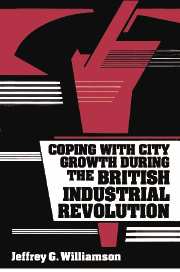Book contents
- Frontmatter
- Contents
- List of tables
- List of figures
- Acknowledgments
- 1 Coping with city growth, past and present
- 2 The urban demographic transition: Births, deaths, and immigration
- 3 Migrant selectivity, brain drain, and human capital transfers
- 4 The demand for labor and immigrant absorption off the farm
- 5 Absorbing the city immigrants
- 6 The impact of the Irish on British labor markets
- 7 Did British labor markets fail during the industrial revolution?
- 8 Did Britain's cities grow too fast?
- 9 City housing, density, disamenities, and death
- 10 Did Britain underinvest in its cities?
- References
- Index
5 - Absorbing the city immigrants
Published online by Cambridge University Press: 03 May 2010
- Frontmatter
- Contents
- List of tables
- List of figures
- Acknowledgments
- 1 Coping with city growth, past and present
- 2 The urban demographic transition: Births, deaths, and immigration
- 3 Migrant selectivity, brain drain, and human capital transfers
- 4 The demand for labor and immigrant absorption off the farm
- 5 Absorbing the city immigrants
- 6 The impact of the Irish on British labor markets
- 7 Did British labor markets fail during the industrial revolution?
- 8 Did Britain's cities grow too fast?
- 9 City housing, density, disamenities, and death
- 10 Did Britain underinvest in its cities?
- References
- Index
Summary
How did city labor markets work? The Todaro model
Debate over Third World urbanization generates the same gloomy pessimism that characterized Britain in the early nineteenth century. Even the rhetoric is the same, Victorian and modern critics both citing urban underemployment, primitive housing, inadequate public services, poverty, and inequality (Williamson, 1988). As we have seen, many modern analysts view the Third World as “overurbanized,” a position shared by many Victorian reformers in nineteenth-century England. According to this view, the cities are too large and too many, and they got that way somehow through perverse migration behavior. Pushed off the land by technological events in agriculture, by famine, and by Malthusian pressure, rural emigrants flood the cities in far greater numbers than modern-sector jobs can be created for them. Attracted by an irrational optimism that they will be selected for those scarce high-wage city jobs, the rural emigrants keep coming. Lacking high-wage jobs in the growing modern sectors, the glut of rural immigrants spills over into low-wage service sectors, unemployment, and pauperism, while their families crowd into inadequate housing blighting an otherwise dynamic city economy. The cities find it difficult to cope with the immigrant influx, and authorities look for ways to close the cities to new immigrants.
By focusing on expected rather than current earnings differentials, Michael Todaro (1969) developed a framework that could account for the apparent irrationality of rural immigrants rushing to the city even in the face of unemployment and underemployment. The Todaro framework and its extensions (Harris and Todaro, 1970; Stiglitz, 1974; Corden and Findlay, 1975; Cole and Sanders, 1985; Hatton and Williamson, 1989) has enjoyed considerable popularity over the past decade or so.
- Type
- Chapter
- Information
- Coping with City Growth during the British Industrial Revolution , pp. 102 - 128Publisher: Cambridge University PressPrint publication year: 1990



